Pakhira aquatica and its cultivation
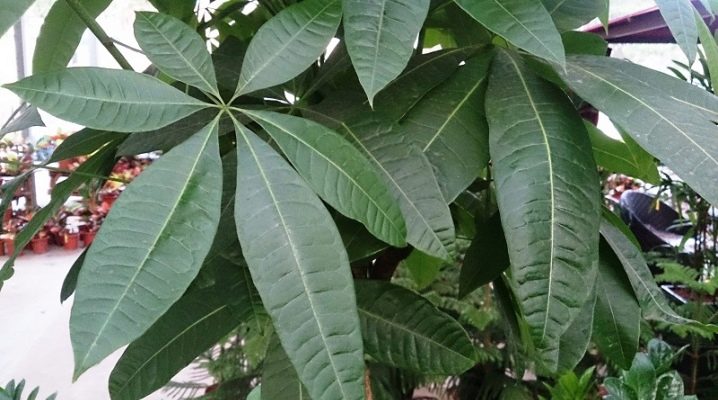
Pakhira aquatica is a rather eccentric plant that can often be found in a flower shop. The culture is grown at home, not only as an interior decoration, but also as a medicinal and edible plant. Next, we will talk about care, description, diseases and pests of pakhira.
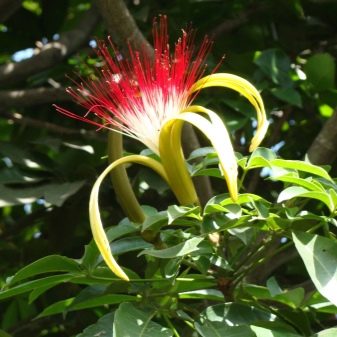
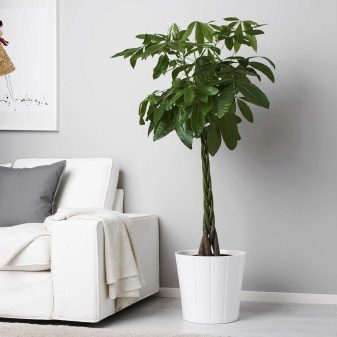
Description
It is a tropical plant that mainly grows in America, in its central and southern parts. Pakhira aquatica belongs to the genus of baobabs. It is often called water pakhira, saba nut or Guiana chestnut. Exot refers to evergreens. Green foliage grows on long petioles. The flowering phase of the plant is lengthened: from June to November. The flower of pale pink color has a vanilla smell: there are many of them on the chestnut, all of them are collected in a panicle. After flowering ends, a small nut-shaped fruit appears. Once ripe, the fruit is considered edible.
The plant can grow up to two meters in height, and the growth is quite fast. At the base, the trunks are thickened, like a bottle, and as they grow in height, they narrow. Leaves grow only at the top. No wonder this plant is also called the baobab. In nature, in addition to aquatic pakhira, there are also such varieties as round-leaved and silvery. Exot improves indoor climate by releasing air ions, ozone and oxygen. Helps with insomnia, neuroses.
And it is also able to calm down aggression and excessive human activity, strengthens the immune system, reducing the growth of the pathogenic environment, thereby creating a favorable psychological microclimate.

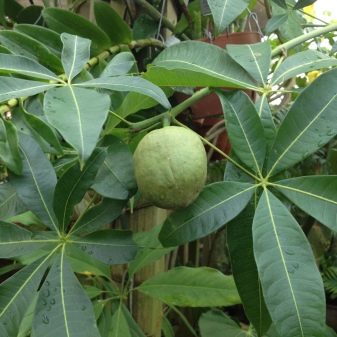
Care
This is a delicate plant for our latitudes, because it is not for nothing that the tropics are considered its homeland. Therefore, in order for the saba nut to please with its flowering, serve as a decoration for the house, it is necessary to follow some rules. The plant is not very common on the windowsills of Russians, only amateurs know about it. But, for example, in the East it is called a money tree, considering that it brings monetary wealth to the house. There it is spread everywhere. People believe that it is pakhira that contributes to the accumulation of money.
Here are some grooming secrets.
- With abundant watering and poor lighting, the exotic will grow faster and only stretch upward.
- Lush crown and intertwined stems - such beauty is achieved not in one year. If you see such a charm in a store, know that she is at least 6-8 years old.
- If fresh seeds are planted in moist soil at a temperature of 30 degrees, then seedlings will appear much faster.
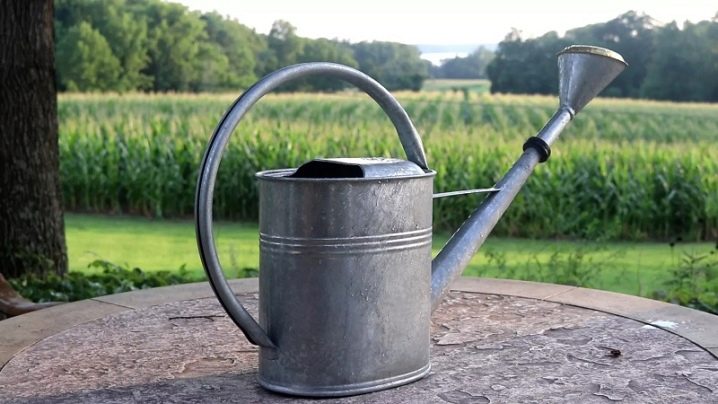
Conditions
At home, pakhira loves warmth: in summer she needs a temperature of 20-25 degrees, and in winter - about plus 15 degrees. The plant does not like dry air, does not tolerate drafts. In the place where the chestnut grows, it is required to create good lighting. Otherwise, the stem will always stretch upward in search of light. It is best to put a container with exotic on the east or west side.
In the summer, pakhira is determined by a place in the garden, on the balcony or on the terrace. But it is recommended to monitor the absence of drafts and precipitation. In winter and autumn, the plant should be under a phytolamp.
Watering
Basically, pakhira is watered in moderation. It is better to irrigate when the soil in the pot has become dry. From autumn to the end of winter, it is recommended to water no more than once a week. Pour warm water either into a tray or along the edge of a container.
It is recommended to leave a little water in the pan, and the green mass should be sprayed from a spray bottle twice a week. In summer, it is good for the exotic to arrange a shower with warm rainwater.
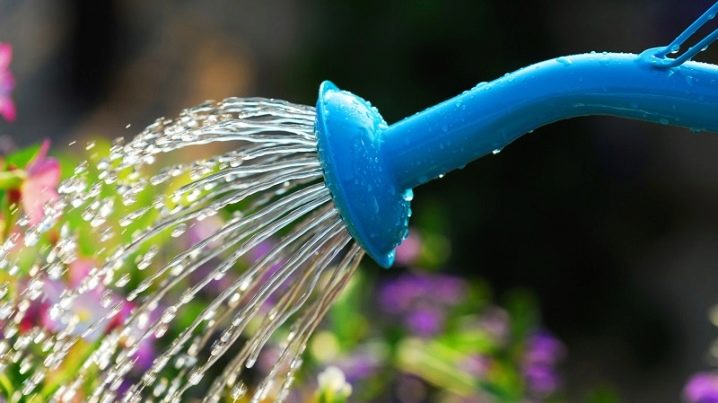
Pruning
Pruning an exotic plant is best done in the spring. For this, the stretching branches are removed, and in their place branching soon occurs. The plant can be shaped like a ball or oval.
To stop active growth, the tops can be slightly pinched. In this case, the crown becomes lush. The size of the shoots is regulated by pruning with the onset of spring. Some growers braid the trunks into a braid, and the lower leaves are specially removed. It is important not to overdo it here: you cannot pull the stems too tightly.
Reproduction
Experts recommend propagating pakhira aquatic in two ways - by seeds and cuttings. With the arrival of spring, the seeds are laid out in a shallow container and watered lightly with water. After that, they are closed with polyethylene or glass, sent to a warm place. It is recommended to ventilate the mini greenhouse every day. After 2.5-3 weeks, the first shoots can be observed. With cuttings, everything is simple: small shoots are cut off along with the heel, and they are rooted in the ground when covered.
A young plant is advised to transplant with the arrival of spring. The transplant is performed once every three years. For transplanting, it is better to select a container with a diameter of 5 centimeters larger than the previous one. It should be wide but shallow. The root system is superficial, so it is not recommended to deepen the plant. The soil is prepared in advance by mixing turf, leafy soil and sand in equal proportions. Don't forget about the drainage system: it can consist of charcoal and crushed red brick.
If it is not possible to prepare the soil yourself, then it is convenient to use a ready-made substrate labeled "for dracaena" or "for palms".
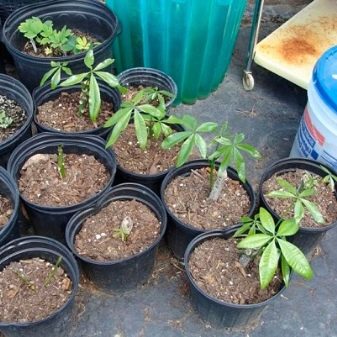
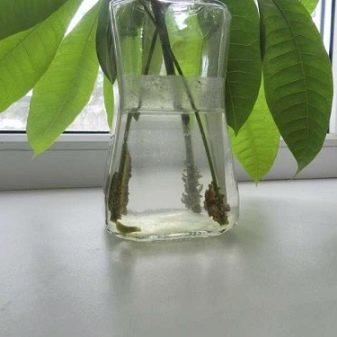
The acidity of the soil mixture should be reduced, and the composition should be loose. The saturation of the soil with nutrients is not particularly important, because the exotic does not even need fertilization. But top dressing can be applied during the period of active growth - from the beginning of spring to the onset of autumn. It is during this period that fertilization is recommended once every two weeks. Mineral complexes are used for ornamental plants by adding to the soil or spraying with antistress drugs. It should be remembered that the dosage should be 50% of the recommended rate.
If an adult plant was purchased in a store, you should not rush to plant it. In a store container, it can be within a year. It is recommended to transplant a large flower only by transshipment into previously prepared soil.
There are several reasons for the transplant:
- there is a huge amount of nitrogen in the soil, which is unfavorable for chestnut;
- the container has become cramped;
- a year has passed since the acquisition;
- pests appeared.
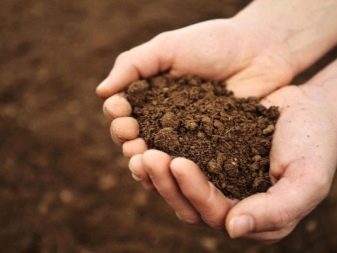
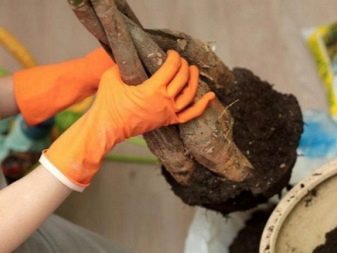
Diseases and pests
The main enemies of the flower culture are the scale insect and the spider mite. All problems arise from improper care: in this case, the air humidity was reduced. After detecting problems, it is necessary to treat the plant with Aktara three times at weekly intervals. If scale insects are found, then it is necessary to wipe the leaf plates and the stem with a solution of alcohol, soap and water. The smallest whitish spots - aphids - appeared on the stems and leaves. It is best to remove it by hand, and then treat it with a napkin or cloth dipped in soapy water. Sometimes knowledgeable people put geraniums next to the chestnut - it can scare away all "ill-wishers".
Another problem is thrips. These are elongated small pests that leave small black specks on the greenery. They must be collected with a cotton swab or other fluffy object. Agravertin, Aktellik, Fitoverm will work well here. Sometimes white worms start on the surface of the earth, which spoil the appearance of the plant, bringing it to death. To get rid of them, it is necessary to spill the soil with a mixture of potassium permanganate and water, and then sprinkle the surface with chopped hot pepper.
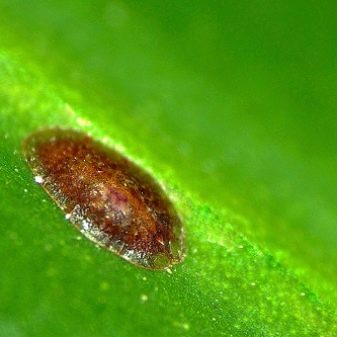

Other problems include the following.
- Branches and leaves withered. This happens due to improper watering. As soon as watering is adjusted, then the fruit crop will come to life.
- The sheet mass began to curl. This problem occurs when the temperature changes or when the temperature is too low.
- The leaves began to turn yellow - it means that something has happened to the root system: root decay due to abundant watering, the appearance of pests, poverty of the soil.
- A whitish coating appeared on the leaf plates - this is the work of a spider mite. It is urgent to apply "Aktara".
- Dry white spots on the leaves indicate sunburn. It is necessary to change the location of the pakhira.
- Leaves drooping from top to bottomthat have lost their elasticity indicate excessive watering. It is necessary to reduce the intensity of watering.
- White fluffy spots on leaf plates talk about the occurrence of powdery mildew. Treatment with fungicides such as "Topaz", "Skor" is recommended.
- The stem becomes soft, covered with small dark spots - attacked by root rot. In this case, a lot of work remains to be done. It is necessary to remove the plant, clean it from the earthy coma, and gently rinse the roots. If the affected area is large, then there is nothing to save. If the rot has just begun to work, then the damaged parts must be cut off with special scissors. Dark spots also need to be cut from the trunk. Powder all damaged parts with activated carbon, treat with fungicide, plant in new soil.
Pakhira aquatica is an exotic plant native to tropical forests. But with proper care at home, a flower culture can not only delight with lush greenery, but also with beautiful flowers, and even delicious fruits.
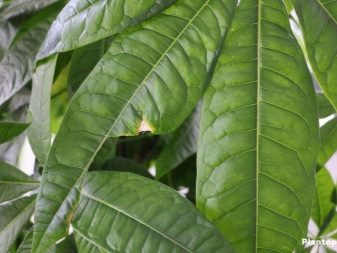
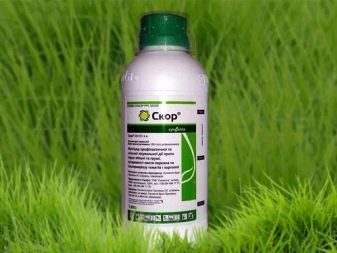













The comment was sent successfully.